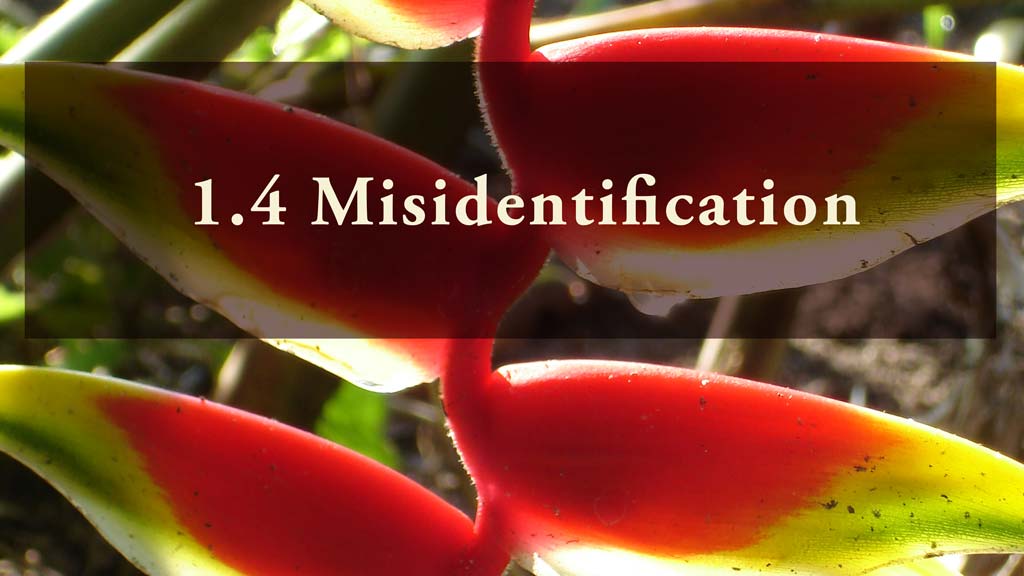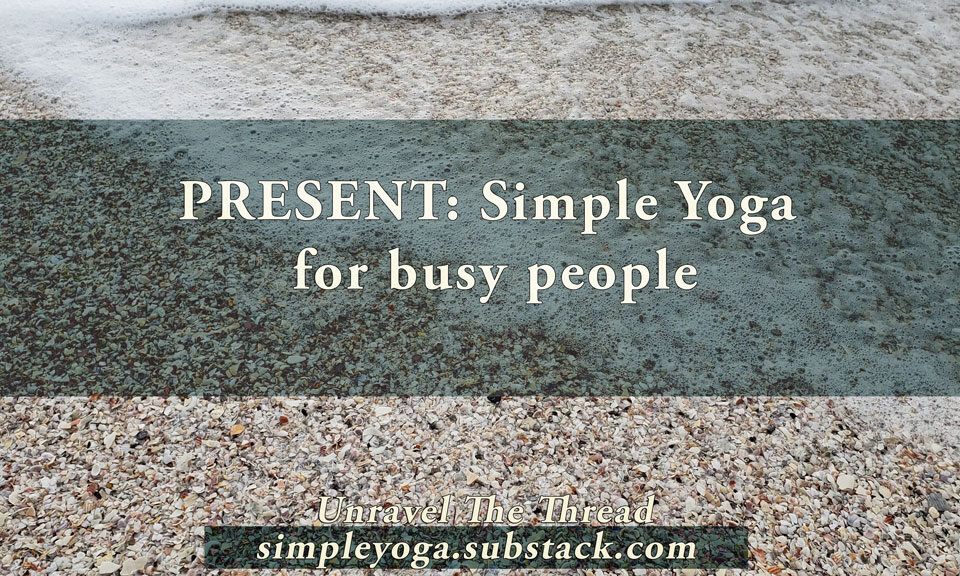
1.3 As a result, embodied presence
March 16, 2019
1.5 Know your Tendencies
March 31, 2019
1.3 As a result, embodied presence
March 16, 2019
1.5 Know your Tendencies
March 31, 20191.4 Misidentification


Yoga Sutra 1.4: Instead of identifying with your ways of being.
As you explored your true nature in the previous dutra, you probably noticed how quickly your mind offered answers for the questions inviting you to feel directly your own height, the color of your eyes, your age and name. This sutra suggests that there is a fundamental difference between who you are and who you think you are.
Your true nature is presence, but when body, mind and emotions are not integrated the tendency is to get distracted by your ways of being. The ways of being include the habits you have developed in your attitudes, posture and movements, breathing patterns and in your sense awareness. These ways of being manifest often as internal chatter in your opinions, emotions and memories as well as in the way those opinions influence your perceptions and your actions. This sutra states that you may end up believing that you are your external and internal activities.
For instance, as you listen to yourself talk and think, you can pay attention to your “I am…” statements, such as “I am happy,” “I am worried,” “I am a student,” “I am employed by….” As you notice all of these labels pay attention to notice if you are using them to define who you are. When you examine these labels can you find out to what extent they create a sense of identity, a sense of who you are? In addition, are you aware of how much energy, time and effort you have invested in making that label part of who you are? How much work does it take for you to sustain that portion of your identity? You have acquired most, if not all, of these labels at some point in your life. If the label has not been a part of you all the time, what were you before you had that label? In other words, those labels are temporary because at some point in your life (in the past or future) each one of those labels will not describe you accurately. In fact, every night in order to fall asleep you let go of all labels and ways of being. Not being able to let go of some label or internal activity will probably keep you from falling asleep.
This pair of sutras, 1.3 and 1.4, offer two options, 1.3 says that your true nature is embodied presence. When you are called to act in the world you participate in each moment with an open mind and an open heart. Sutra 1.4 says that the alternative is to misidentify with the habits and tendencies that you have developed. Consider how your internal dialogue and your interactions contribute to crowd your inner world with more labels. Quite likely each label places demands on your time and energy. Furthermore, the labels you and others have chosen to describe you, serve as filters that deeply influence how you perceive yourself and your environment. For instance, if you have heard often that you are not creative or intelligent, these ideas will affect what you think you can and can’t do. Some of the most inaccurate and toxic misconceptions you may hold include: I am not enough, There is something fundamentally wrong with me, I am incomplete, I am not good enough.
Becoming aware of these statements invites you to contemplate how your own ways of being contribute to the quality of your participation in each moment. Are there some ways of being that are not essential to your life? You may answer this question through inquiring into who you think you are. You may also revisit the ideas from the previous episode regarding your true nature. In addition, you can try to notice what you make important in your life.
We can explore the meaning of this sutra with this simple exercise: WHO DO I THINK I AM?
Take a few minutes to write down words that you use to describe yourself. Free write, so that there is no editing or censoring, just write whatever comes to mind. Ready? Start writing answers to the question, who do I think I am?
Now, review the list of words you wrote and ask yourself:
- How long has this word been an accurate descriptor of who I am?
- Have I always used each of these words to describe myself?
- When did I start using some of these words to describe me?
- How long will each of these words describe me accurately?
- Can you think of similar labels you used in the past, but that you no longer use?
- How many of these words are essential? In other words, how many of these labels capture the complete essence of who you are?
- Are there any labels that have always described you accurately?
As you go through this inquiry, you can contemplate the different ideas you identify with. You will probably see how some of those ideas have changed over time. Some of them might be more recent than others, and there may be others that are no longer accurate descriptors of how you see yourself. Furthermore, as you consider your ways of being and labels, remember that a label that is useful in one situation may be unhelpful or irrelevant in a different context. For instance, being organized and systematic can be useful when you are analyzing or calculating something. However, if you are too systematic you may loose the creativity offered by being spontaneous and carefree. Is being stuck in one mode of operation an obstacle to responding congruently to the changing circumstances in your life?
After doing this exercise, we can pay attention to our actions to notice if they reflect what we think. Many of us find that there is a gap between what we think and say is important and what we invest our time, energy and money on. This gap is precisely what this sutra is pointing out, the inconsistencies between what we think or say and what we do.
Besides, is it possible that most labels you use to describe yourself aren’t essential to your being? Understanding this enables you to use your labels without believing that they make you who you are. Every day, at the end of the day you can explore this verse by paying attention to the process of consciously and deliberately releasing all of your labels and ways of being. Notice how you feel as you let go. Beware of emotional attachments to some of those ideas. Practicing this regularly can give you insights into your ways of being and into how you feel when you release them as well as into how they influence the quality of your sleep. You can make note of the labels that you feel attached to and find hard to let go as they may suggest fruitful paths of inquiry.
Pondering these matters can help illuminate the main concept presented in verse 1.4, which is the human tendency to identify with our ways of being, such as our education, age, upbringing and origin, as well as our pain, worries, anxieties, accomplishments, beliefs and circumstances. Many of us may identify with our belongings, our bank account, our title or profession. As we reflect on these ideas, many of us can’t help but hear a couple of questions in our heads: Are you trying to tell me that all of those things I have worked so hard for (like my degrees, position, status and belongings) are not who I am? And, if I am not all those things, then who am I? This is a perennial question. More than trying to find a static and definitive answer, in yoga we are trying to explore the direct experience of being who you are, wherever you are.
Remember that in addition to ways of being in attitude, emotions and thoughts, our bodies are molded by our postural habits and by our movement habits. If you wear the same pair of pants for a full week, when you take the pants off you could easily see the shape that your body is most frequently in. You are actually shaping your own body with your activity patterns. So, if you sit for a many hours a day in front of a computer, your body may be taking a certain shape. That shape will likely condition how you move as well as where your tension accumulates. It will also influence the movements that you can and can’t do. If you identify with your body, are you identifying with the conscious or unconscious shape that it has right now? Notice also that the definition of ways of being would suggest that your emotional patterns, like seeing the world as a place of scarcity or a place of abundance will influence your thoughts, mood, breathing, choices and actions.
As it was mentioned in the previous episode, sutras 1.3 and 1.4, suggest two basic modes of operation, being and doing. Doing is an outward orientation while being is an inward orientation. Yoga regulates your ways of being at all levels to strike a dynamic balance between being and doing that is conducive to living in integrated harmony, inside and outside.
Of course, you can also choose to chant this sutra as a way to feel its vibrations directly in your own body and to reflect on all of these ideas. You may prefer to chant the traditional version:
वृत्ति सारूप्यमितरत्र ॥४॥ vṛtti sārūpyamitaratraor, its simplified version with each word chanted individually:
- vṛtti
- sārūpyam
- itaratra
Unravel the thread is now available as a book!
If you find Simple-Yoga.org and Unravel the thread useful, consider supporting my labor with a donation, you may also donate using PayPal or Venmo. Thank you!
